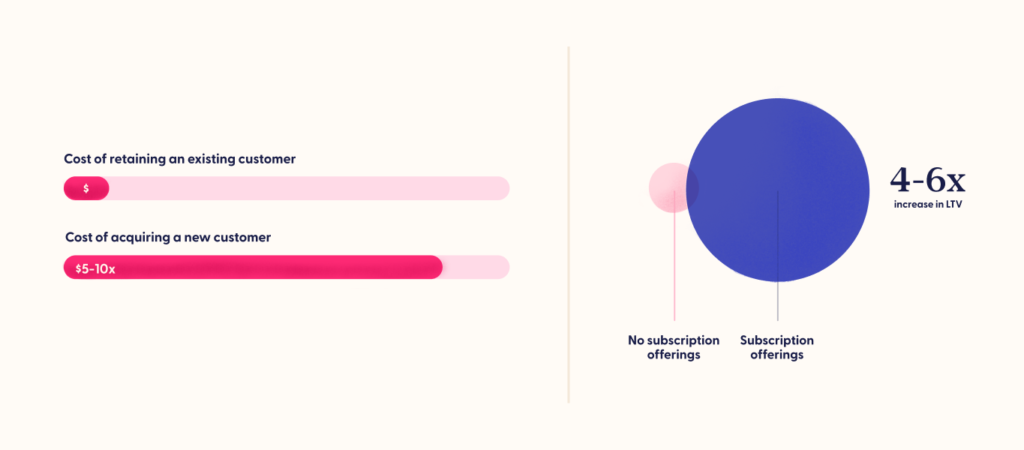If your ecommerce brand is new to subscriptions, the benefits of a subscription management solution are monumental. This type of software solution allows you to launch recurring offerings more quickly and easily than you would be able to with a home-grown fix. In turn, this allows you to focus on building a base of loyal subscribers while tapping into the power of a recurring revenue stream.
The best subscription management software allows you to create highly flexible subscription services that your customers can edit themselves, improving brand loyalty and the customer experience. Ultimately, when your subscriptions are flexible, you can strengthen your customer relationships and maximize customer lifetime value (LTV).
Before implementing a subscription management solution, however, there are key steps your business should take to set yourself up for success. By laying the groundwork in this way, you can get the most out of your investment and maximize the benefits of subscription revenue for your store.
In this series of blog posts, we’re breaking down everything you need to know about subscription management. We’ve already covered the five different types of subscription management solutions, the secret to ecommerce integrations, and the most common elements of a subscription management solution. In this post, we’ll cover how merchants who are new to subscriptions can optimize their business before implementing subscription management software.
For more in-depth information on managing subscriptions, download our free ebook, A Merchant’s Guide To Subscription Management.

Before choosing a subscription management platform, optimize your overall business
Before moving forward with subscriptions and choosing a relevant provider, it’s important to make sure several key aspects of your business are in order. In particular, this is the time to start thinking about your subscription priorities and make sure you’re set up to deliver a best-in-class experience for your recurring customers.
Optimize your product-market fit
First things first: Think about what products or services you want to sell via subscription. Are there any of your products that are typically purchased more than once by the same customers?
From there, think about whether those products or services are best suited to be sold via the replenishment, curation, or access subscription model. For example, if you sell eco-friendly cleaning products, and a group of your customers regularly purchases refills of your laundry detergent each month, you’d be well-suited for the replenishment subscription model.
Finally, start small. Choose one or two products for your initial subscription launch. Monitor their performance closely and glean as much as you can from the experience before honing your strategy and growing your subscription offerings.
Prioritize your customer experience
As you consider different software providers, prioritize those that can make it easy for your customers to manage subscriptions themselves. Your customers want flexibility, be it in the form of flexible delivery dates, product options, or even the ability to change their orders via text. Confirm that your chosen provider is able to meet these essential needs.
Don’t just consider the ways your customers can manage their own subscriptions—invest in your Customer Support team. Make sure your customers have somewhere to seek additional support when needed, and communicate those options clearly.
Determine your subscription priorities
Before choosing a subscription management provider, it’s crucial to get all your priorities in order. Determine your ideal launch date, budget, customization needs, and security requirements, then pinpoint which providers are best able to meet those needs. Remember, you’re not just choosing a provider for your business in its current state: You want a provider that will grow with you.
Set up your logistics for future success
The operational aspects of a subscription business—particularly shipping and tax needs—cannot be overlooked. Before choosing a provider, it’s critical to get these elements right to make sure all your bases are covered.
Please note that merchants should always consult with a local tax expert to ensure they’re charging customers the correct sales tax.
Determine your shipping needs
To determine your shipping needs, first identify how you’re currently fulfilling your orders. From there, pinpoint the ideal carrier rates for your business. Finally, consider how your shipping rates may be applied in the future depending on the subscription management system you choose.
Determine your tax needs
It’s important to determine not only your tax needs, but also whether or not you have tax liability and/or tax nexus. This depends on a variety of factors, including:
- The states in which you have warehouses or distribution centers—you’ll very likely have sales tax nexus in those states
- The states in which you have sales transactions—depending on state, county, and district regulations, you may have certain tax liabilities
- The products or services that you sell—if you sell digital downloads or goods, these can have complex nexus rules that vary state to state
- The U.S. states with which you have physical or economic connections—it’s very likely you will need to charge sales tax for these states
- Any countries outside of the U.S. in which you conduct business or do business with—this will help you determine if your business needs to charge tax outside of the U.S.
Make sure your analytics capabilities can effectively measure your success
Before launching customer subscriptions, it’s important to measure your baseline for several key metrics, including LTV, average order value (AOV), and churn rate. By gaining a deeper awareness of where you currently stand, you can track any trends and changes over time once you launch your subscriptions.
If you’re not currently able to capture your performance for these metrics, be sure to prioritize subscription management tools that will allow you to do so in the future.
From there, determine which metrics you’d like to improve through the subscription business model, and confirm that your chosen provider is able to track those metrics over time. Finally, if you have any additional analytics needs (such as cohort tracking), be sure your chosen provider can perform those functions as well.
Setting up a strong subscription foundation is well worth your effort
It takes time and effort to optimize your business for subscriptions, but putting this effort in before you choose a subscription management solution paves the way for best-in-class subscriptions that grow with your subscribers. After all, subscriptions mean more than just recurring billing—they pave the way for lasting relationships with your customers that stand the test of time.
Interested in learning more about the different types of subscription management solutions? Download A Merchant’s Guide to Subscription Management for free today.



